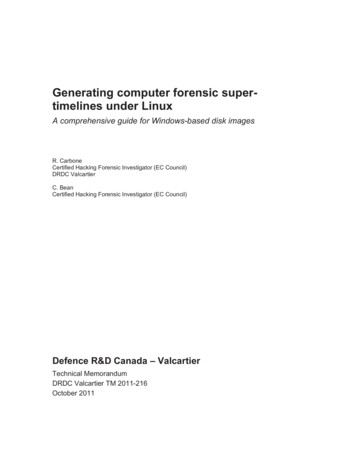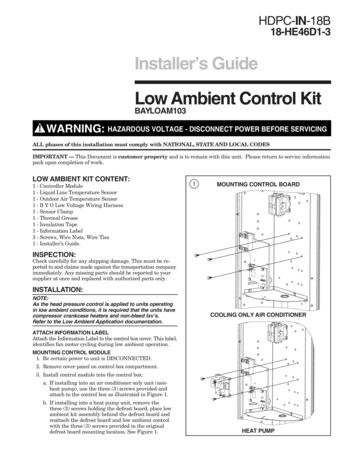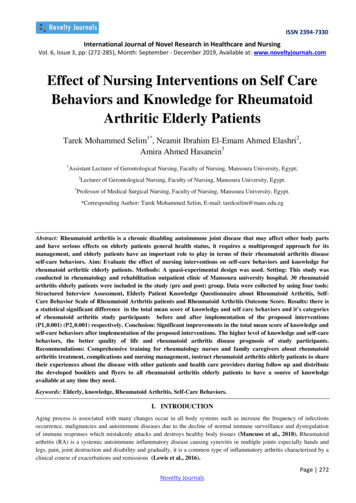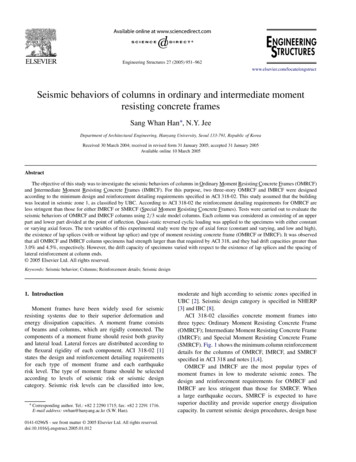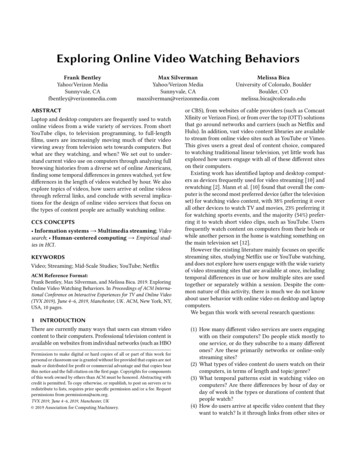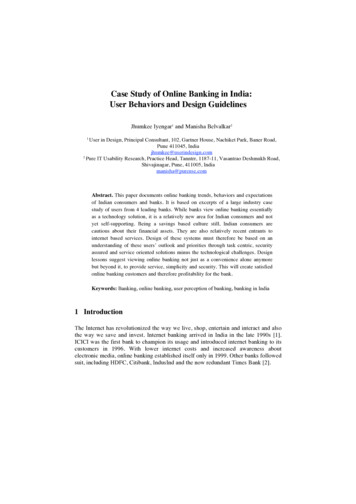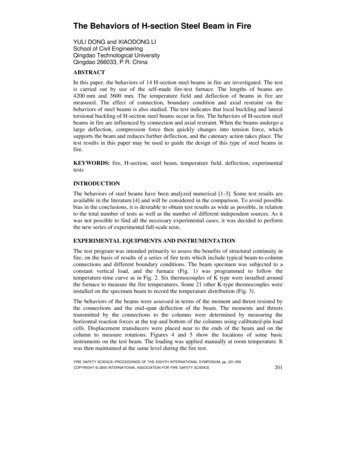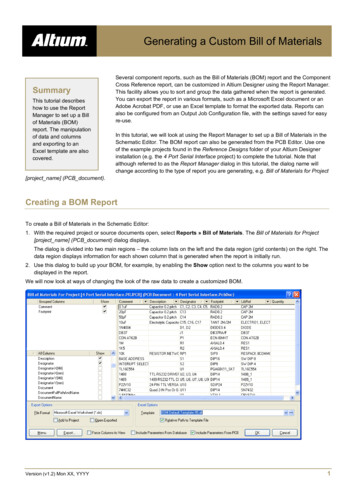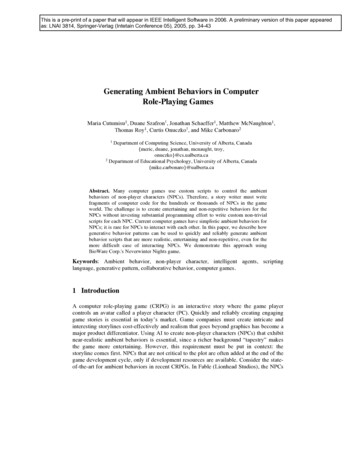
Transcription
This is a pre-print of a paper that will appear in IEEE Intelligent Software in 2006. A preliminary version of this paper appearedas: LNAI 3814, Springer-Verlag (Intetain Conference 05), 2005, pp. 34-43Generating Ambient Behaviors in ComputerRole-Playing GamesMaria Cutumisu1, Duane Szafron1, Jonathan Schaeffer1, Matthew McNaughton1,Thomas Roy1, Curtis Onuczko1, and Mike Carbonaro21Department of Computing Science, University of Alberta, Canada{meric, duane, jonathan, mcnaught, troy,onuczko}@cs.ualberta.ca2Department of Educational Psychology, University of Alberta, Canada{mike.carbonaro}@ualberta.caAbstract. Many computer games use custom scripts to control the ambientbehaviors of non-player characters (NPCs). Therefore, a story writer must writefragments of computer code for the hundreds or thousands of NPCs in the gameworld. The challenge is to create entertaining and non-repetitive behaviors for theNPCs without investing substantial programming effort to write custom non-trivialscripts for each NPC. Current computer games have simplistic ambient behaviors forNPCs; it is rare for NPCs to interact with each other. In this paper, we describe howgenerative behavior patterns can be used to quickly and reliably generate ambientbehavior scripts that are more realistic, entertaining and non-repetitive, even for themore difficult case of interacting NPCs. We demonstrate this approach usingBioWare Corp.'s Neverwinter Nights game.Keywords: Ambient behavior, non-player character, intelligent agents, scriptinglanguage, generative pattern, collaborative behavior, computer games.1 IntroductionA computer role-playing game (CRPG) is an interactive story where the game playercontrols an avatar called a player character (PC). Quickly and reliably creating engaginggame stories is essential in today’s market. Game companies must create intricate andinteresting storylines cost-effectively and realism that goes beyond graphics has become amajor product differentiator. Using AI to create non-player characters (NPCs) that exhibitnear-realistic ambient behaviors is essential, since a richer background “tapestry” makesthe game more entertaining. However, this requirement must be put in context: thestoryline comes first. NPCs that are not critical to the plot are often added at the end of thegame development cycle, only if development resources are available. Consider the stateof-the-art for ambient behaviors in recent CRPGs. In Fable (Lionhead Studios), the NPCs
wake at dawn, walk to work, run errands, go home at night, and make random commentsabout the disposition and appearance of the PC. However, the behaviors and commentsare “canned” and repetitive and NPCs never interact with each other. The Elder Scrolls 3:Morrowind (Bethesda Softworks) has a huge immersive world. However, NPCs eitherwander around areas on predefined paths or stand still, performing a simple animation,never interacting with each other and ignoring the simulated day. In The Sims 2(Electronic Arts), players control the NPCs (Sims) by choosing their behaviors. Each Simchooses its own behaviors using a motivational system if it is not told what to do. Theambient behaviors are impressive, but they hinge on a game model (simulation) that isintegral to this game and not easily transferable to other game genres, including CRPGs.Halo 2 (Bungie) is a first person shooter with about 50 behaviors, including support for“joint behaviors” [1]. The Halo 2’s general AI model is described, but no model for jointbehaviors is given. Façade [2] has an excellent collaborative behavior model for NPCs,but there are only a few NPCs, so it is not clear if it will scale to thousands of ambientNPCs. They also comment about the amount of manual work that must be done by awriter when using their framework. Other research includes planning, PaTNets, sensorcontrol-action loops [3], and automata controlled by a universal stack-based controlsystem for both low-level and high-level animation control, but not in the domain ofcommercial-scale computer games. However, planning is starting to be used incommercial computer games in the context of Unreal Tournament [4]. Crowd controlresearch involves low-level behaviors such as flocking and collisions and has recentlybeen extended to a higher-level behavioral engine [5]. Group behaviors provide a formalway to reason about joint plans, intentions and beliefs. Our approach is dictated by thepractical requirements of commercial computer games. Our model is robust, flexible,extendable, and scalable [6] to thousands of ambient NPCs, while requiring minimal CPUresources. Moreover, our generative pattern abstraction shields story designers frommanual scripting and the synchronization issues of collaborative behaviors, and allowsthem to concentrate on story construction.In most games, scripts control NPC behaviors. A game engine renders the story worldobjects, generates events on the objects, dispatches events to scripts and executes thescripts. Different stories can be “played” with the same game engine using story-specificobjects and scripts. Programmers create game engines using programming languages suchas C or C . Writers and artists, who are not usually programmers [7], write game storiesby creating objects and scripts for each story. The goal of our research is to improve theway game stories, not game engines, are created.A writer may create thousands of game objects for each story. If a game object mustinteract with the PC or another game object, a script must be written. For example,BioWare Corp.’s popular Neverwinter Nights (NWN) (http://nwn.bioware.com) campaignstory contains 54,300 game objects of which 29,510 are scripted, including 8,992 objectswith custom scripts, while the others share a set of predefined scripts. The scripts consistof 141,267 lines of code in 7,857 script files. Many games have a toolset that allows awriter to create game objects and attach scripts to them. Examples are BioWare’s Auroratoolset that uses NWScript and Epic Game’s UnrealEd that uses UnrealScript.
The difficulties of writing manual scripts are well documented [8]. Writers want tocreate custom scripts without adapting predefined scripts or relying on a programmer towrite custom scripts. However, story creation should be more like writing thanprogramming.ScriptEase (http://www.cs.ualberta.ca/ script) is a publicly available tool for creatinggame stories using a high-level menu-driven “programming” model. ScriptEase solves thenon-programmer problem by letting the writer create scenes at the level of “patterns” [9].A writer begins by using BioWare’s NWN Aurora toolset to create the physical layout ofa story, without attaching any scripts to objects. The writer then selects appropriatebehavior patterns that generate scripting code for NPCs in the story. For example, in atavern scene, behavior patterns for customers, servers and the owner would be used togenerate all the scripting code to make the tavern come alive. Figure 1 shows a NWNtavern scene in which the ambient behaviors for several customers (“This place is gettingbetter and better”, “A walk is nice”), two servers (“Good crowd tonight”, “I’m on myway, Traiani”) and an owner (not shown) have been generated. The PC is at the front ofthe scene and determines the camera location. The ScriptEase generative pattern approachis much easier for non-programmers than manually scripting events, even if a library ofbehaviors such as the Memetic AI toolkit (http://www.memeticai.org) is used.Figure 1. An NWN tavern scene with ScriptEase ambient behaviors.We already showed that ScriptEase is usable by non-programmers, by integrating itinto an interactive short story creation exercise in the Grade 10 high school Englishcurriculum [10]. The version of ScriptEase that was used had a rich set of patterns forsupporting interactions between the PC and inanimate objects such as doors, props andtriggers. It also had limited support for plot and dialogue patterns (the subject of on-goingwork). We have now extended the generative pattern approach of ScriptEase to supportthe ambient behaviors of NPCs [11].
NPC interactions require concurrency control to ensure that neither deadlock norindefinite postponement can occur, and to ensure that interactions are realistic. Weconstructed an NPC interaction concurrency model and built generative behavior patternsfor it. We used these patterns to generate all of the scripting code for a tavern scene toillustrate how easy it is to use behavior patterns to create complex NPC interactions. Theambient background includes customers, servers and an owner going about their businessbut, most importantly, interacting with each other in a natural way, based on our novelapproach to NPC ambient behaviors. It is the first time patterns have been used togenerate behavior scripts for computer games. The research makes three keycontributions: 1) rich backgrounds populated with interacting NPCs with realistic ambientbehaviors are easy to create with the right model, 2) pattern-based programming is apowerful tool and 3) our model and patterns can be used to generate code for a real game(NWN).2 Ambient Behavior PatternsA CRPG tavern scene demonstrates ambient behavior patterns. We define three ambientbehavior patterns for this scene: owner, server, and customer. Each behavior generatesmore complex interactions than most NPCs display in most CRPGs.A behavior pattern is defined by a set of behaviors and two control models that selectthe most appropriate behavior at any given time. A behavior can be used proactively (P) ina spontaneous manner or reactively (R) in response to another behavior. Table 1 lists thebehaviors used in the tavern. Some are used independently by a single NPC. For example,posing and returning to the original scene location are independent behaviors. This articleaddresses only high-level behaviors, since the NWN game engine solves low-levelproblems. For example, if the original location is occupied by another creature when anNPC tries to return, the game engine moves the NPC as close as possible and subsequentreturn behaviors may succeed. Behaviors that involve more than one NPC arecollaborative (joint) behaviors. For example, an offer involves two NPCs, one to make theoffer and one to accept/reject it.The first column of Table 1 indicates whether a proactive behavior is independent orcollaborative. Note that interactions with the PC are not considered ambient so they arenot supported by ambient behavior patterns. The most novel and challenging ambientbehaviors are the ones that use behaviors collaboratively (interacting NPCs). The secondcolumn lists the proactive behaviors. The letters in parentheses indicate which kind ofNPC can initiate the proactive behavior. For a collaborative behavior, the kind ofcollaborator is given as part of the behavior name, e.g., the approach random C behaviorcan be initiated by a server or customer (S, C) and the collaborator is a random customer(C).
Table 1. Behaviors in the Server (S), Customer (C), and Owner (O) Patterns.Behavior TypeIndependentCollaborativeProactive BehaviorReactive Chainspose (S, C, O)return (C, O)approach bar (S, C)fetch (O)approach random C (S, C)talk to nearest C (C)converse with nearest C (C)ask-fetch nearest S (C, O)ask-give O (C)offer-give to nearest C (O)pose, donereturn, doneapproach, donefetch, doneapproach, donespeak, speak, converse*(speak, speak) donespeak, fetch, receive, speak, donespeak, give, receive, speak, donespeak, decide, ask-give*;(accept)speak, decide, speak, done(reject)speak, decide, ask-fetch*;(accept)speak, decide, speak, done(reject)offer-fetch to nearest C (S)The third column of Table 1 shows the reactive chains for each proactive behavior. Forexample, the ask-fetch proactive behavior has a reactive chain where the initiator speaks(selecting an appropriate one-liner randomly from a conversation file), the collaboratorfetches (goes to the supply room while speaking), the initiator receives something, thecollaborator speaks and the done behavior terminates the chain. Each reactive chain endsin a done behavior, unless another chain is reused (denoted by an asterisk such asconverse* in the talk behavior). Each behavior consists of several actions. For example, aspeak behavior consists of facing a partner, pausing, performing a speech animation anduttering the text. An entry marked with () indicates that the parenthesized behaviors arerepeated one or more (random) times. For example, the converse proactive behavior startsa reactive chain with one or more speak behaviors alternating between two NPCs. Thetalk proactive behavior starts a reactive chain with a speak behavior (a greeting) for eachinterlocutor, followed by a converse behavior. The offer-give (owner offers a drink) andoffer-fetch (server offers to fetch a drink) proactive behaviors each have two differentreactive chains (shown in Table 1) depending on whether the collaborator decides toaccept or reject the offer.The writer uses a simple process to create these behaviors, with no programming(script writing) involved. Begin by using the Aurora toolset to construct the tavern area,populate it with customers, servers and an owner, and save the area in a module. Open themodule in ScriptEase and perform three kinds of actions. First, create one instance of theserver, customer and owner patterns respectively, by selecting the patterns from a menu.Second, set the options of each pattern instance to game objects and/or values using dialogboxes. For example, the server has three options that must be set – the Actor, the Barand the Customer. Each is set to an object constructed using the Aurora toolset. Notethat one pattern instance can generate code that is used by all game objects with the sametag (Server), created in the Aurora toolset. The third step is to select the “Save and
Compile” menu command to generate NWScript code (for the entire tavern scene) thatcoul
Role-Playing Games Maria Cutumisu1, Duane Szafron1, Jonathan Schaeffer1, Matthew McNaughton1, . integral to this game and not easily transferable to other game genres, including CRPGs. Halo 2 (Bungie) is a first person shooter with about 50 behaviors, including support for “joint behaviors” [1]. The Halo 2’s general AI model is described, but no model for joint behaviors is given .
